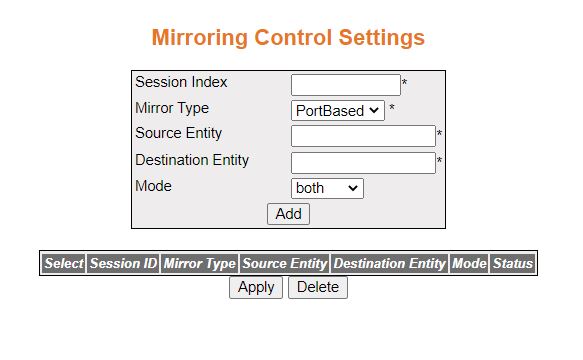This section describes how to configure the Mirroring
feature.
The Mirroring feature is introduced
in switches because of a fundamental difference that switches have with
hubs. When a hub receives a packet on one port, the hub sends out
a copy of that packet to all ports except to the one from where
the hub received the packet. After a switch boots, it starts to
build up a Layer 2 forwarding table on the basis of the source MAC address of the different packets
that the switch receives. After this forwarding table is built,
the switch forwards traffic that is destined for a MAC address directly to corresponding
ports.
The switch can support up to 7 port mirroring sessions.
Note: The RSPAN feature is not supported at this time.
To access Mirroring screens, go to .
ISS Mirroring Control Settings
Figure 1. ISS
Mirroring Control Settings

| Screen Objective |
This screen allows the user to configure the
Mirroring Control Settings. |
| Navigation |
|
| Fields |
- Select—click
to select the session ID for which the configuration has to be modified
or the session needs to be deleted.
- Session Index—enter the index of the
mirroring session. This value is from 1 to 20. The maximum number
of sessions per switch is 7.
- Mirror Type—the available option is port-based—receives
/ transmits mirroring packets depending on Mirroring mode (ingress/egress/both)
on “source” port(s) to “destination” port(s) to 20.
- Source Entity—enter the source entity
which participates in a mirroring session. This is a combination
of interface type and interface ID. The interface ID is a combination
of slot number and port number (slot number/port number). For example,
gi0/1, fa0/1, po1.
|
| Fields |
- Destination Entity—enter
the destination port entity from which the packets will be transmitted.
This is a combination of interface type and interface ID. The interface
ID is a combination of slot number and port number (slot number/port number).
For example, gi0/1,fa0/1.
- Mode—select the mode of mirroring. The
default option is Both. The list contains:
- ingress—mirrors
only traffic that is ingressing to the source ports
- egress—mirrors only traffic that is egressing from the source
ports
- both—mirrors both traffic that is ingressing to the source ports
and egressing from the source ports
- Status—displays the status of the Mirror
Control Extension table entries. The list contains:
- Up—indicates
the status of Mirror Control Extension table entries as enabled.
- Down—indicates the status of Mirror Control Extension table
entries as disabled.
- Under creation—indicates that the Mirror Control Extension table
entries are under creation.
|
| Buttons |
- Add—adds and
saves new configuration
|